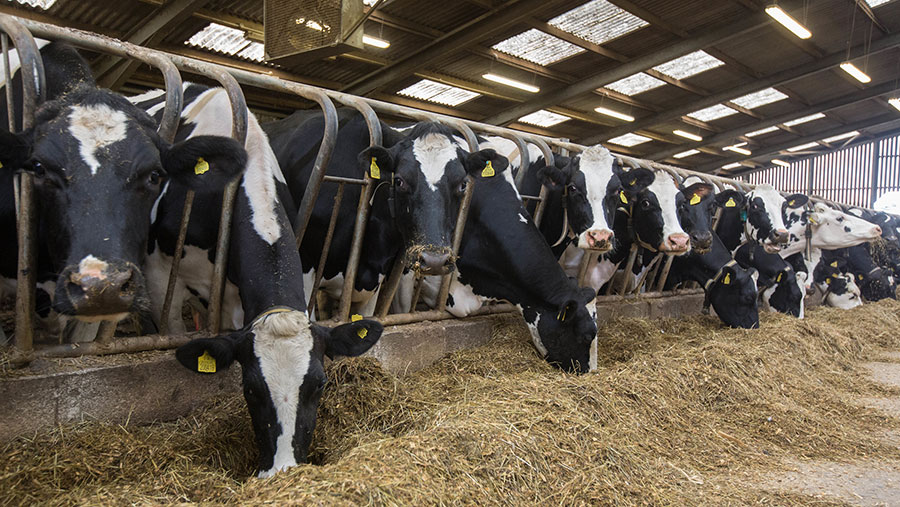Action needed on farm to manage distiller price surge
 © Tim Scrivener
© Tim Scrivener Scottish farmers are struggling to source cheap distiller by-products due to prices being driven up by the energy sector.
Constultants, who say the problem won’t “disappear”, are urging farmers to make better use of home-grown quality forage.
Prices of pot ale syrup have increased about £10/t, while draff has doubled in price and the cost of dried dark distiller’s grains is rising too as biomass and AD units take lorryloads for biofuel.
See also: How to budget for dairy feed supplements
Meanwhile, high-quality dairying feeds remain difficult to source. This has led farm advisers to issue strong preharvest messages.
Plan for winter
Speaking to Farmers Weekly, SAC consultant Karen Stewart said farms must keep in touch with suppliers well ahead of winter to check availability.
“Reasonably priced alternatives are maize gluten, which is currently good value if finishers are short of barley and wheat dark grains also look quite favourable,” said Mrs Stewart.
“It’s more important than ever to get rations looked at and forages analysed to work out economical options that will still perform well.”
How to overcome the shortage
Pre-harvest questions
- Can I lift the metabolisable energy and protein levels of my silage and minimise waste?
- Is there any wholecrop I could use as a replacement energy source?
- Can I feed more cereals safely and what processing options could be used on farm?
- When does the market price of by-products become too costly relative to other available feeds?
- Are there any cereal growers in the area I could buy off the combine or the field?
Plan ahead
- Forward plan your diet and quantities of feed required
- Reduce reliance on spot loads of by-products that may or may not arrive
- Buy forward and lock in prices you can manage
- Look for opportunities in the market noting currency volatility, world market conditions and surpluses available at harvest.
Source: David Keiley, dairy nutritionist, Kite Consulting
Consider DM content
William Davidson, Davidsons Animal Feeds operations director, said farms need to grow the best forage they can at home and reassess feed on a price per percent of DM basis.
He says farmers unable to get hold of by-products should go “back to the drawing board”.
“Produce the best quality forage you can at home as the base of the diet,” explained Mr Davidson. “Distillers by-products don’t need to lift in price much before dry feeds look competitive because of the haulage costs involved in hauling the water in the wet feed.”
Straights trader Iain Reid of East Coast Viners Animal Nutrition said by-products from North East England’s Ensus (meal) and Vivergo (pellet) plants were heading into Scotland to address some supply issues.
However, with these products about £185/t and £190/t delivered to the Aberdeenshire area respectively, Mr Reid said this was not as economical as draff at £25/t, even when adjusting for DM difference, due to the increased haulage costs involved.
“In past years it was common for Aberdeenshire farms to buy 1,000t or more of wet draff products and sheet it for winter feed when prices were about £8-£12 delivered on farm or even less,” explained Mr Reid.
However, now traders are reporting a two-fold lift in draff prices in two years, with prices of £20-£25/t for the Aberdeenshire area and up to £40/t for the South West.
A protein option for farms near ports could be soya which has fallen about £50/t to nearly £6.14/protein unit, explained Mr Reid. This now compares to dried distiller’s pellets from Vivergo at £6.12/unit.
But while soya supplies a broad amino acid profile, soya at this price will not be non-GM, he adds.
Rumen function
Many farms have benefited from feeding high energy distillers by-products to high levels because there is little acidosis risk, said SAC beef specialist Jimmy Hyslop.
Furthermore, pot ale syrup is a great source of rumen degradable protein, for which some operations may need to find a replacement.
“If you think about what they are they are cereals with the starch taken away, leaving you with oil, protein and fibre,” explains Dr Hyslop.
“Starch is energy but the oils and proteins left in the products are energy sources as well. Oil has more than twice as much energy as carbohydrate on a gross energy basis.”
Dr Hyslop added rapeseed meal, maize gluten and barley also supply rumen degradable protein (RDP) for rumen microbes.
Rapeseed meal can be up to 38% crude protein (CP) of which 75-85% is RDP, while barley is 10-11% CP and generally 70-80% of this is RDP, he explains. There’s also maize gluten, which is 8-1 0CP and 60-70% RDP.
